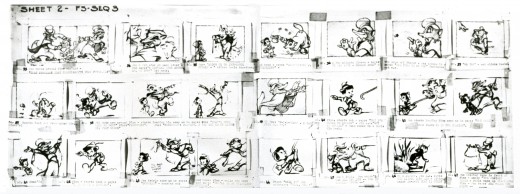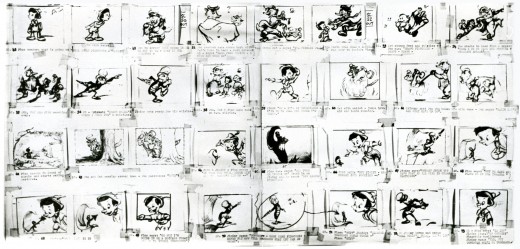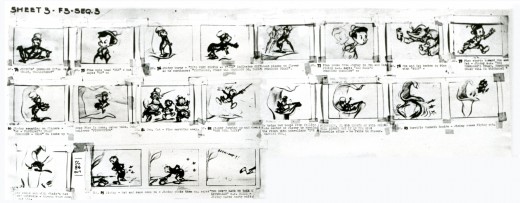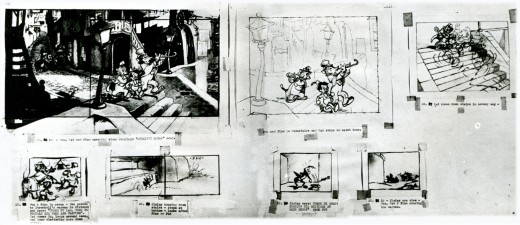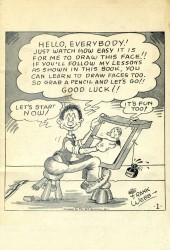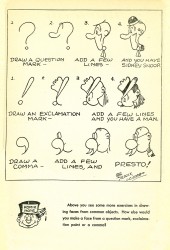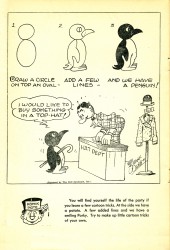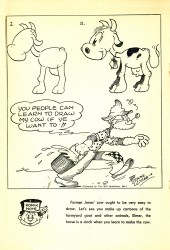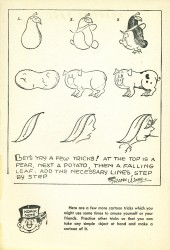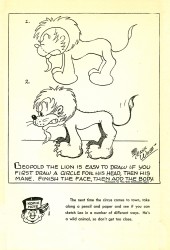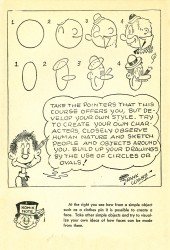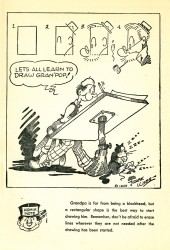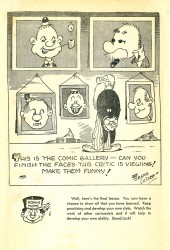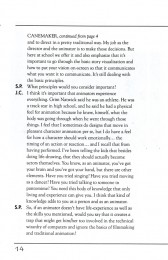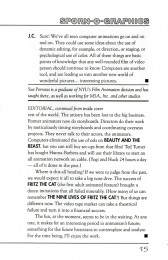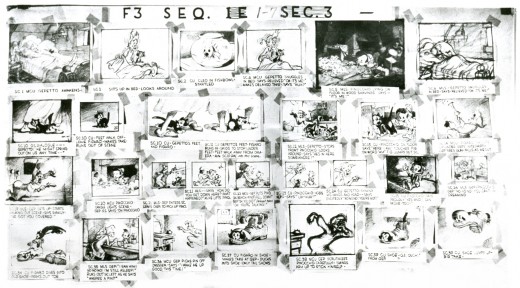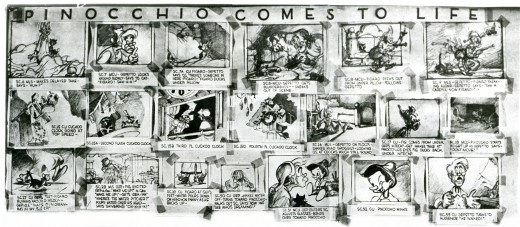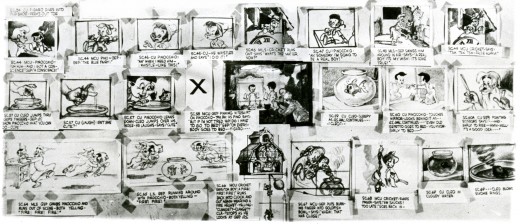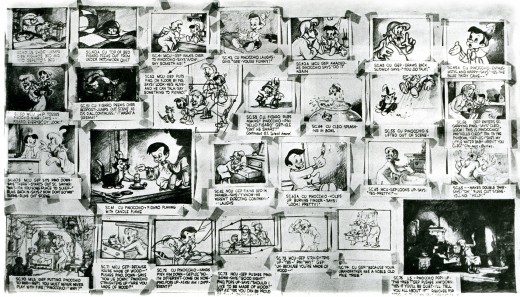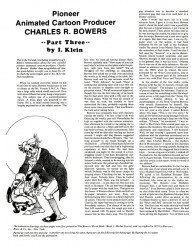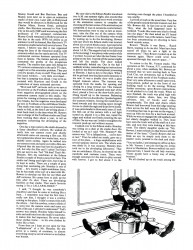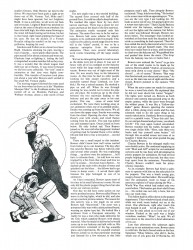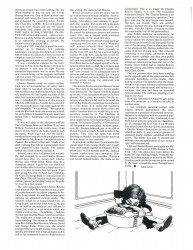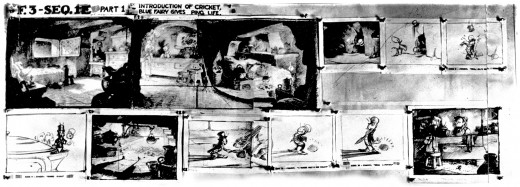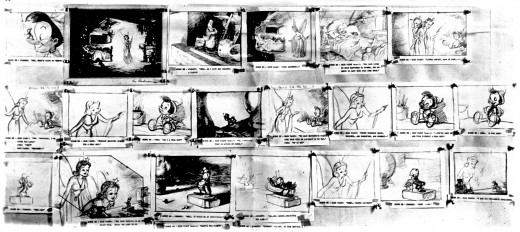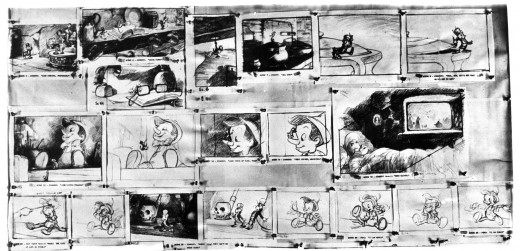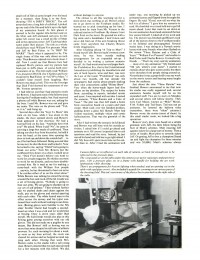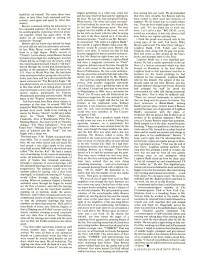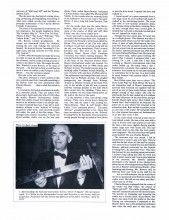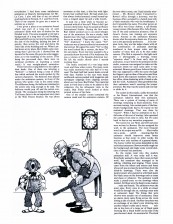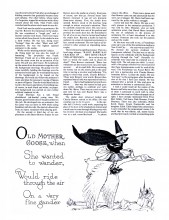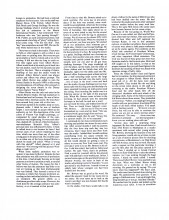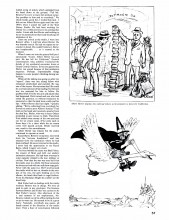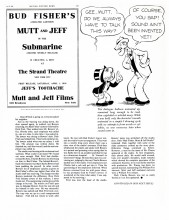Monthly ArchiveMarch 2007
SpornFilms &Story & Storyboards 21 Mar 2007 08:00 am
Story (board)
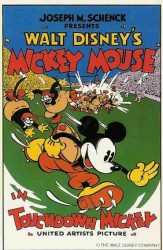 – With all this presentation of storyboards and storyboard documents, it was a real find to come upon the document Didier Ghez posted on his site, Disney History. It’s a story outline from Walt, himself, for the 1932 short Touchdown Mickey. The telling piece comes from the collection of Mark Sonntag.
– With all this presentation of storyboards and storyboard documents, it was a real find to come upon the document Didier Ghez posted on his site, Disney History. It’s a story outline from Walt, himself, for the 1932 short Touchdown Mickey. The telling piece comes from the collection of Mark Sonntag.
Obviously, there was something of a real give-and-take in the Disney films re script vs storyboard creation. Thanks to Merritt & Kaufman’s Walt In Wonderland, we saw documents like this for the silent shorts. However, I don’t remember too many treatments published for the sound shorts.
Of course, if this is the case for the short films, it’s obvious that more elaborate treatments were done for the features.
Oddly, this resembles the “scripts” written for the Larry David Show. On the set of that show the actors improvise dialogue around the breakdowns Larry David writes. The improvisation develops on its own and is pared down or built up in the editing of the final films.
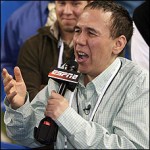 We did something like this in the making of The Little Match Girl. We’d hired Gilbert Gottfried in 1989 – long before Aladdin – to improvise the narration track in the recording studio. My writer, Maxine Fisher, had to write a one-page treatment of the Anderson tale for Gilbert to take into the recording booth. He read the treatment and kept elaborating on it making a lot of jokes as he read.
We did something like this in the making of The Little Match Girl. We’d hired Gilbert Gottfried in 1989 – long before Aladdin – to improvise the narration track in the recording studio. My writer, Maxine Fisher, had to write a one-page treatment of the Anderson tale for Gilbert to take into the recording booth. He read the treatment and kept elaborating on it making a lot of jokes as he read.
The full track was cut down to the half-hour format, and we storyboarded that. Adjusting. Adjusting Adjusting. (Gilbert Gottfried)
.
 Eventually, the overseas distributor, the video client, and HBO all asked us to get rid of the angry, yelling voice. They were financing it, so I had to, sadly, alter the track. It became a massive job since the cadences of Gottfried were so different from anyone else. 1/3 of the animation had been completed, and a lot of changes had to happen.
Eventually, the overseas distributor, the video client, and HBO all asked us to get rid of the angry, yelling voice. They were financing it, so I had to, sadly, alter the track. It became a massive job since the cadences of Gottfried were so different from anyone else. 1/3 of the animation had been completed, and a lot of changes had to happen.
We wrote a script from the old storyboard, including some of Gilbert’s jokes, and F. Murray Abraham did a great job of acting out the new narration.
(F. Murray Abraham)
In the end, I had a bit of difficulty watching the film again. It had taken so many turns. Sheila Nevins, the chief at HBO, asked me six months later if I thought this my best film. She loved it so much. I had to watch the movie again to think about it.
Stuff happens.
Sorry for that riff, but I guess this story is on my mind since we’re releasing the dvd of The Little Match Girl in companionship with The Red Shoes this coming June. We’ve been making “The Making ofs … ” for the past couple of months, and I’ve been thinking about it.
I still do think a lot about the script/storyboard/script methodology and have seen a lot of variations. I couldn’t help but point one out. I also have a lot more to say on the subject, but I’ll hold off for another time. I have a UPA storyboard by T.Hee I want to show you.
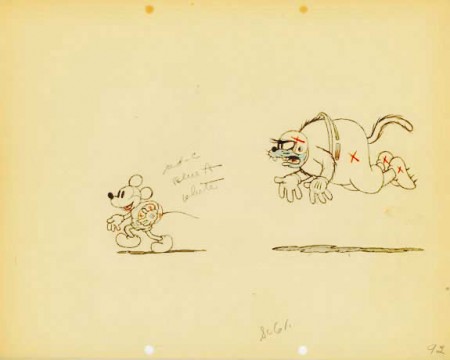
It’s interesting that I own a 16mm copy of Touchdown Mickey as well as the dvd, of course. I’ve seen the short many times and like it, but I have a lot of other B&W ones I like more. Now if it were Baseball Mickey I might feel differently.
Animation Artifacts &Commentary 20 Mar 2007 07:33 am
Kimball
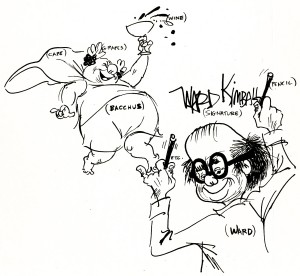 – I notice that there were a number of sites today featuring articles and material about Ward Kimball, (e.g. here and here) and there’s the Ward Kimball/My Space page which I visited. Jaime Weinman has a post that presents thoughts which I certainly agree with. In fact, they could have been mine.
– I notice that there were a number of sites today featuring articles and material about Ward Kimball, (e.g. here and here) and there’s the Ward Kimball/My Space page which I visited. Jaime Weinman has a post that presents thoughts which I certainly agree with. In fact, they could have been mine.
A year ago, I posted a couple of Kimball drawings. These came to me years ago (the 70′s?) via John Canemaker. The Bacchus drawing appeared in his Nine Old Men book. I have a few more drawings by Ward Kimball, and I thought it’d be nice to post a few of them.
I’ve always had mixed feelings about Kimball’s work. On the one hand his persona as presented to the public was always annoying. He came off as the wacky cartoonist who just wanted to show you how wacky he was. (There was a hint of this in Chuck Jones, as well.) He obviously had a big ego and had good reason for it. There was no doubt that this guy could draw like a son-of-a-gun, and his animation was often breathtaking. It always sided more toward the cartoon rather than the real, and it had a style so different from the others. You had to admire it.
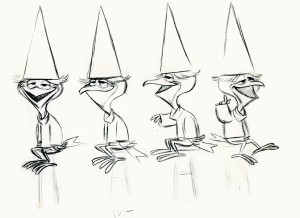 The crow sequence in Dumbo is brilliant, to say the least; the Mad Hatter in Alice is the heart of that film (though I wish it weren’t), and the Cheshire cat the most memorable part; and Toot Whistle Plunk & Boom is probably the best short done at Disney’s after WWII. However, there’s nothing I liked about the Oscar winning It’s Tough To Be Bird or Dad Can I Borrow The Car?. (This is a good example of Kimball’s personality entering the films.)
The crow sequence in Dumbo is brilliant, to say the least; the Mad Hatter in Alice is the heart of that film (though I wish it weren’t), and the Cheshire cat the most memorable part; and Toot Whistle Plunk & Boom is probably the best short done at Disney’s after WWII. However, there’s nothing I liked about the Oscar winning It’s Tough To Be Bird or Dad Can I Borrow The Car?. (This is a good example of Kimball’s personality entering the films.)
(Click any image to enlarge.)
.
The interview Mike Barrier did with Kimball in 1969-1986 offers some good insight into the man and some excellent detail. It adds to the piece Canemaker wrote in The Nine Old Men. Many people have written about Kimball, but I think John Canemaker‘s book has to cover his career best. It brings him to life and gives us a good encapsulation of his life and work.
.
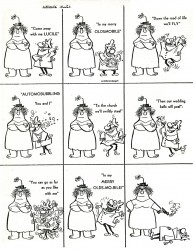
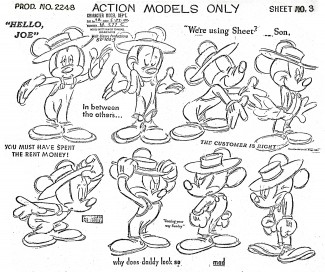
The comic to the left is obviously and ad parody, but don’t ask me what this Mickey compilation model sheet is. What’s with all the type?
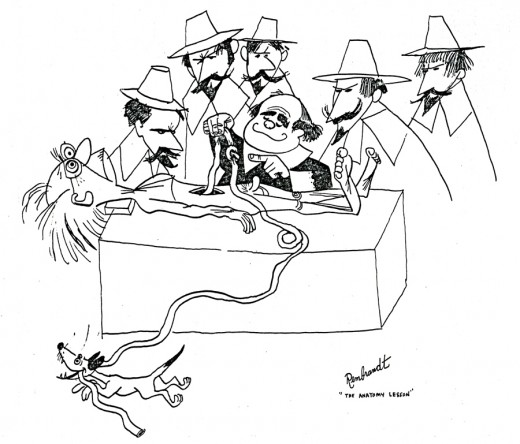
This was obviously a card for someone (Oliver Wallace?) who was operated on. I’m sure I’d have enjoyed something this funny if I was trying to recuperate.
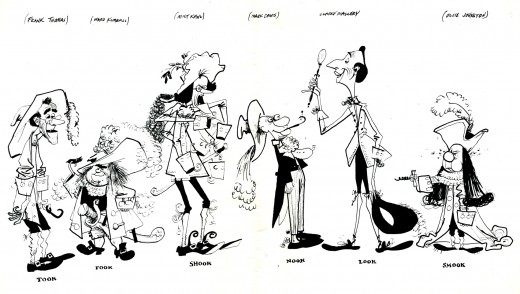
This caricature tells you that there must have been some real competition among the animators as the Captain Hook character approached.
You can watch some Kimball clips on YouTube (until someone takes them down.)
Disney Family Album Opening and Part 1 and Part 2.
Escalation, an independent anti-war (Viet Nam) short
the Snow White soup eating scene P.T.
Thad Komorowski has posted quite a few clips from Kimball. Here are some:
Cinderella‘s Lucifer
Dumbo‘s crows
Mother Goose Goes Hollywood 1, 2, 3
The Three Caballeros
Animation Artifacts &Story & Storyboards 19 Mar 2007 08:07 am
Pinocchio Board #3
- Here’s the third installment of the Pinocchio storyboards loaned to me by John Canemaker.
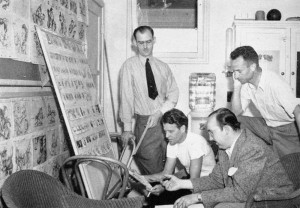 A bit of history about these boards seems appropriate. In the early 1950s, Dave Hand (the director of Snow White and Bambi, among others) gave the photos of these pages to Borge Ring (brilliant Oscar-winning Dutch animator). This information came from Hans Perk on his excellent blog A Film LA as he completed posting all the Drafts to Pinocchio.
A bit of history about these boards seems appropriate. In the early 1950s, Dave Hand (the director of Snow White and Bambi, among others) gave the photos of these pages to Borge Ring (brilliant Oscar-winning Dutch animator). This information came from Hans Perk on his excellent blog A Film LA as he completed posting all the Drafts to Pinocchio.
Borge brought in a photographer to rephotograph these boards which he gave to John. Years later they were loaned to me, and I’m posting them.
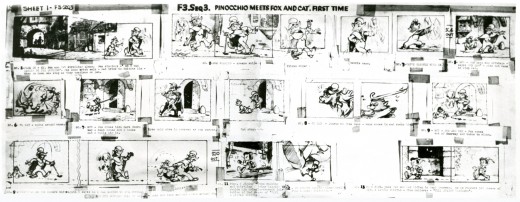 1a
1a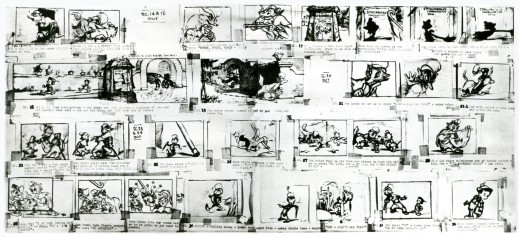 1b
1b
(Click any image to enlarge.)
Books 18 Mar 2007 08:21 am
More Faces of Frank Webb
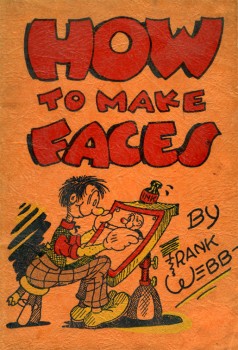 – Last August, I posted bits of the book How To Make Faces which I am pleased to own. It comes from a completely different era, and contains drawings which remind me of my childhood. Romps to the public library rummaging through any book that had whatever remote connection to animation or cartooning.
– Last August, I posted bits of the book How To Make Faces which I am pleased to own. It comes from a completely different era, and contains drawings which remind me of my childhood. Romps to the public library rummaging through any book that had whatever remote connection to animation or cartooning.
I vaguely remember seeing this book there and was happy to find it on ebay. Every so often I flip through it and smile at the drawings. There’s some funny work there, and I wonder how many kids used it to try to learn how to draw cartoons.
Just this past week I received an interesting comment on that post; here it is:
-
Hi,
Frank Webb was my great uncle, and I am very pleased to have found someone who still knows of him. I have a bunch of his stuff, and know a bit about his history, including him publicly proclaiming Walt Disney a crook! One of Franks drawings ended up in a sale to Disney, and renamed (from “Dippy Dogâ€) to Goofy. Thank you for including him here.
Darren Reese
This was just the excuse I needed for sharing a bit more of this booklet. I didn’t see any resemblance of Dippy Dog, but there is a guy who looks a bit like Farmer Alfalfa. I hoped I wasn’t alone in appreciating Mr. Webb’s cartoons, and now I know I’m not. Here are a few more pages. In the pages I posted last time, Frank Webb showed how to make cartoons from letters of the alphabet. This time he works in a more traditional manner.
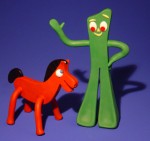 – Speaking of Old Timers, Gumby celebrated his 50th birthday last week. All 200 episodes of the “Gumby Show” will be released in dvd this fall. However you can watch episodes of the show for free at AOL or YouTube.
– Speaking of Old Timers, Gumby celebrated his 50th birthday last week. All 200 episodes of the “Gumby Show” will be released in dvd this fall. However you can watch episodes of the show for free at AOL or YouTube.
A remastered version of the 1995 “Gumby Movie” will premiere next month at the Tribeca Film Festival in New York.
Congratulations to Art Clokey. Still going strong.
Articles on Animation &SpornFilms 17 Mar 2007 08:34 am
Sporn-O-Graphics #4
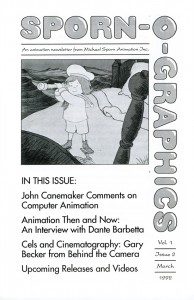 – In the early 1990′s we produced a little mimeographed magazine about animation, particularly animation within our studio. It was called Sporn-O-Graphics. About 1000 copies were sent out to a lot of people on our mailing list, no requests, no fees. We just sent them to whomever we wanted. We produced five issues of this publication, though only four were ever sent out.
– In the early 1990′s we produced a little mimeographed magazine about animation, particularly animation within our studio. It was called Sporn-O-Graphics. About 1000 copies were sent out to a lot of people on our mailing list, no requests, no fees. We just sent them to whomever we wanted. We produced five issues of this publication, though only four were ever sent out.
Since there are a couple of interesting bits in them, I’ve decided to post a couple of those interviews/articles on this site. For some of the pieces it’s re-releasing information; for others it’s fun looking back on some quaint, dated material.
In issue #4 we had two interviews:
Dante Barbetta is a first rate animator who worked at Paramount, NYIT and a lot of the commercial studios in NY. Some of his last animation was done for us on a couple of our half-hour shows.
(Click any image to enlarge.)
Denise Gonzalez, who put together this issue of Sporn-O-Graphics, interviews Dante. I wish this article had been more in-depth considering the wealth of knowledge Dante houses, but it’s good to give him any attention we can.
John Canemaker, the Oscar winning film maker, teacher and noted animation historian, is interviewed by Sue Perotto (a great animator and animation director, in her own right), John’s former student. The article focuses on the changing technology, and obviously is now dated, (it was done pre Toy Story) but I enjoyed rereading it and think you might as well.
This is Dante Barbetta ‘s interview:
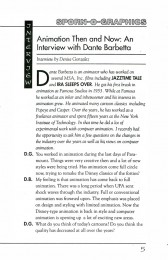 1
1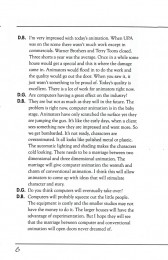 2
2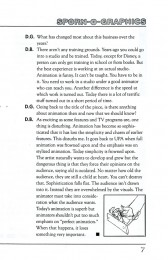 3
3
This is the John Canemaker interview:
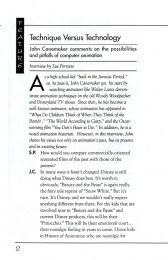 1
1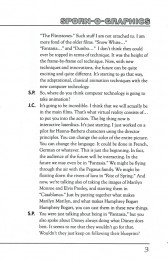 2
2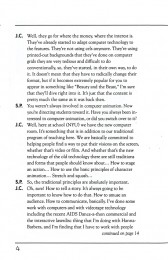 3
3
Animation Artifacts &Story & Storyboards 16 Mar 2007 08:09 am
Pinocchio Board #2
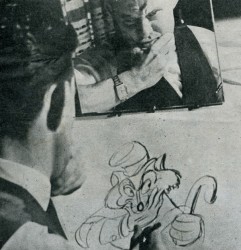 - Here’s the continuation of some of the Pinocchio storyboards which were loaned to me by John Canemaker. As Eddie Fitgerald and Floyd Norman pointed out in comments, these probably aren’t continuation boards; certainly they wouldn’t title one “Pinocchio Comes To Life.” My guess is that these were photographed for publicity, or else perhaps they’re early versions (except that the characters are obviously on model.)
- Here’s the continuation of some of the Pinocchio storyboards which were loaned to me by John Canemaker. As Eddie Fitgerald and Floyd Norman pointed out in comments, these probably aren’t continuation boards; certainly they wouldn’t title one “Pinocchio Comes To Life.” My guess is that these were photographed for publicity, or else perhaps they’re early versions (except that the characters are obviously on model.)
The two boards here seem to be two versions of the same sequence but different. The first one is compressed with lots of captions underneath the images; the second board is more spread out, more in the flow of the other boards.
(Click any image to enlarge.)
Regardless of why these boards were constructed, they contain images and thoughts that are good to see. Here they are; Gepetto discovers a real boy that was once a puppet:
Addendum: the images have been rearranged per comments of “the spectre” below. Now 1a goes to the left of 1b. 2a goes to the left of 2b.
Articles on Animation 15 Mar 2007 07:56 am
I.Klein’s Charles Bowers – part 3
- Here is the third and final installment in the Charles Bowers article by noted animator, I.Klein. This final article appeared in the Sept. ’75 issue of Cartoonist Profiles magazine.
I want to thank Mark Mayerson for volunteering to post the article when it seemed that I wasn’t going to be able to locate it. (As long as the information gets out there, I’m happy.)
Rob Farr has an overview of Charles Bowers‘ life and career on his site, Mug Shots, which is a home page of all the forgotten silent film comics. (Don’t forget that Boweers, teamed with Harol L. Muller, made many silent comedies. Farr includes extensive quotes of news articles and reviews about Bowers.
Tomorrow morning I’ll post the next couple of Pinocchio boards “Pinocchio Comes To Life.”
Animation Artifacts &Story & Storyboards 14 Mar 2007 08:16 am
Pinocchio Board #1
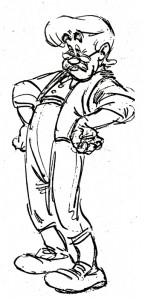 – John Canemaker came for a short visit and brought the real gold with him. He’s loaned me the photographic stats of the Pinocchio storyboard. The entire board isn’t there, but there’s sure a lot of it. We start with the Blue Fairy sequence. F3-1.3.
– John Canemaker came for a short visit and brought the real gold with him. He’s loaned me the photographic stats of the Pinocchio storyboard. The entire board isn’t there, but there’s sure a lot of it. We start with the Blue Fairy sequence. F3-1.3.
So I’ll post it a bit at a time. They’re large scans that have to be reconstructed in photoshop, and I’m doing that as time permits. I’m also trying to clean it up a bit since it’s a rather dark image. I’m trying to post it at the highest possible resolution so that it can be read, but that means I have to cut it in half again or it otherwise won’t load. (Since the board reads across row by row, I’m splitting it lengthwise to make reading easier.)
The type is still a bit small, but it’s the best I can do.
It’s a gem and something that should be out there now while Hans Perk posts the Drafts to the film and Mark Mayerson continues his Mosaic of the entire film. Hopefully, I’ll be able to catch up and keep up with him – a couple of posts a week.
Happy reading:
Articles on Animation &Fleischer 13 Mar 2007 07:00 am
I.Klein’s Charles Bowers – part 2
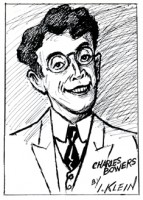 – So when we last left I. Klein yesterday, he was telling us about Charles Bowers. Bowers was a silent film animation pioneer and entrepeneur. He’s done enough that I think he deserves a little more attention by historians, but there isn’t much interest in and information about the silent film animators. Other than Winsor McCay, not too many early pioneers have been the focus of attention. Even someone as important as J.R. Bray remains a silent shadow in the corner of animation history overshadowed by the likes of Disney and the Fleischers.
– So when we last left I. Klein yesterday, he was telling us about Charles Bowers. Bowers was a silent film animation pioneer and entrepeneur. He’s done enough that I think he deserves a little more attention by historians, but there isn’t much interest in and information about the silent film animators. Other than Winsor McCay, not too many early pioneers have been the focus of attention. Even someone as important as J.R. Bray remains a silent shadow in the corner of animation history overshadowed by the likes of Disney and the Fleischers.
As a matter of fact, other than specific biographies (such as a book I have on Lotte Reineger or John Canemaker‘s books on McCay and Otto Messmer) I can only think of two books which focus on silent film animation. There’s the excellent book, Before Mickey by Donald Crafton, and there’s Walt In Wonderland by Russell Merritt and J. B. Kaufman. Both are must-haves for animation lovers.
Here then is the continuation of I.Klein’s article for Cartoonist Profiles’ June 1975 issue:
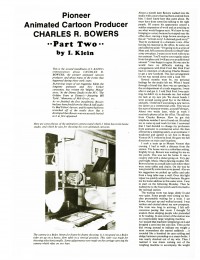 1
1 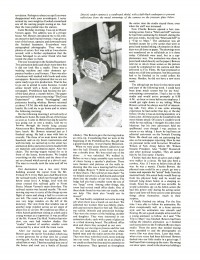 2
2
(Click any image to enlarge.)
Articles on Animation 12 Mar 2007 08:25 am
I.Klein’s Charles Bowers 1
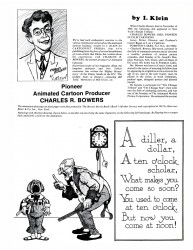 – Charles Bowers was an animation pioneer and entrepeneur. He is often mentioned in animation histories but is given short mention in the same publications. The brilliant book, Before Mickey by Donald Crafton, often mentions Bowers by name and company (Celebrated Film Corporation), but it doesn’t really go into what he did.
– Charles Bowers was an animation pioneer and entrepeneur. He is often mentioned in animation histories but is given short mention in the same publications. The brilliant book, Before Mickey by Donald Crafton, often mentions Bowers by name and company (Celebrated Film Corporation), but it doesn’t really go into what he did.
In fact, he supervised the Mutt and Jeff series for Pathe-Freres and Bud Fisher and was instrumental in trying to get The Katenjammer Kids animated (until law suits from Hearst developed). He invented a new camera for live action and became a moderately successful silent-screen comedian. He also did a couple of puppet animated shorts in 1939 & 1940 which were released by the Fleischers.
(Click on any image to enlarge.)
Additioinally, he was an animator for Loucks & Norling on a World’s Fair film about petroleum done in 3-D (stereo vision), a story writer for Walter Lantz, a published cartoonist, a children’s book author/illustrator, a high-wire walker and at one time a bronco buster. Perhaps his problem was that his energies were too spread out trying to do many different things. Had he been more focussed on a single métier, he might have had more success. (Just a guess.) His is in some ways a typical animation biography.
In March and June of 1975, Cartoonist Profiles published a two-part article by animator, Izzy Klein. Klein witnessed Bowers’ work and writes about it in a very affable style.
Cartoonist Profiles magazine stopped publishing in 2005 when editor Jud Hurd died. I’ve decided to post the two parts of this article: Part 1 here, today. Part 2 later this week.

